 |
|

|
 |
TABLE of CONTENTS
 |
Flood waters, landslides test MnDOT crews |
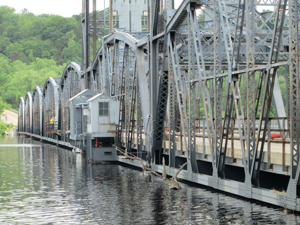
The Stillwater Lift Bridge was closed June 23 due to high water levels on the St. Croix River. Photo by Jessica Wiens |
The Land of 10,000 Lakes gained extra bodies of water this past week as heavy rains caused lakes, rivers and streams to flood in multiple locations, triggering the activation of the State Emergency Operations Center, a State of Emergency declaration and the closure of numerous highways statewide.
And worse.
Two Metro District maintenance workers were injured Sunday, June 22, while doing flood-related work. Dennis Scott and Ron McDeid were placing traffic cones to mark lane closures on northbound Interstate 35W in Burnsville when a vehicle swerved into the work zone and hit their truck. They were part of a team preparing to install dikes on the edge of the roadway.
The men were transported to area hospitals. Scott, a transportation generalist at the Plymouth truck station, was treated and released; McDeid, a transportation operations supervisor at the Golden Valley truck station, remains hospitalized with serious injuries.
“Our thoughts and prayers go out to Ron and Dennis for their complete recovery,” said Sue Mulvihill, deputy commissioner and chief engineer. “When our employees put on their boots and hard hats to make the roads safer for motorists, they expect to return safely to their families at the end of their shift. This is a chilling reminder of how hazardous their work really is, and of the need for motorists to stay alert at all times, especially in work zones.”
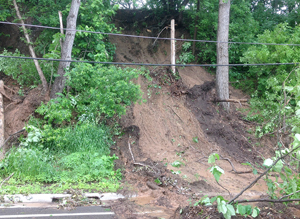
MnDOT closed a section of Hwy 13 in Lilydale for two days after two landslides June 19 uprooted trees and sent other debris across the two-lane road. Mary Wenner, Metro District transportation operations supervisor, was briefly trapped between the landslides but was able to drive her pick-up truck between the smaller landslide and the guardrail to escape the unstable area. Photo by Tom Jordan |
On Thursday, June 19, Mary Wenner, a transportation operations supervisor at Metro District’s Mendota Heights truck station, found herself stuck between two landslides on Hwy 13 in Lilydale, east of I-35E. She had responded to a report of a tree blocking the highway after part of a hill, saturated by heavy rains, broke off and slid across the road. As she and an Xcel Energy rep surveyed the situation, a smaller landslide on the other side of their trucks bookended them on the highway.
They escaped in Wenner’s pick-up truck by squeezing between the smaller landslide and the guardrail, according to Tom Jordan, a transportation operations supervisor at Mendota Heights truck station, who was working at another problem site in the area. The Xcel Energy truck was too big to pass. He said Metro District crews spent 11 hours the following Saturday clearing the highway, including getting the trees out, hauling debris and dumping the mud-clay mixture.
Other highways closed or restricted in the Twin Cities during the past week were the Hwy 41 river crossing in Chaska; the Stillwater Lift Bridge; northbound Hwy 169 south of Belle Plaine and the Black Dog ramp on northbound I-35W in Burnsville.
Other highways around the state that kept MnDOT crews busy include:
- Hwy 19 and Hwy 93 from Henderson to Hwy 169
- Hwy 99 east of St. Peter
- Hwy 169 St. Peter to LeSueur
- Hwy 22 Mankato to St. Peter
- Hwy 212 in McLeod County
- Hwy 65 between Hwy 13 and County Road 91 (Albert Lea)
- Hwy 200 in two locations east of Mahnomen
- Hwy 75 near Kent
- Hwy 11 west of International Falls
See MnDOT’s flood update page for current information, photos and videos of flooding around the state.
Making state roads more resistant to future flood damage
MnDOT’s $50 million statewide flood mitigation program, created after substantial statewide flooding in fall 2010, helps make state roadways more resistant to future flood damage, thus using transportation dollars more efficiently. The work makes the roads safer for the public while reducing repair costs and minimizing traffic disruption from future floods, creating a more sustainable transportation system.
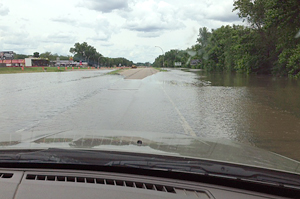
Hwy 169 was closed between St. Peter and LeSueur due to flooding of the Minnesota River. A 2014 flood mitigation project will raise Hwy 169 in this area to maintain traffic flow during high water events. Photo by Jed Falgren
|
Funded through existing bond authority, the flood mitigation projects include improvements to drainage structures, slopes, berms and ditches prone to flooding. Projects also include repairs, realignments or raises to highways that regularly flood.
Flood mitigation projects set for construction in 2014 include:
• Hwy 101 Minnesota River crossing between Shakopee and Chanhassen – Construct new bridge north of existing Hwy 101 Minnesota River Bridge and raise existing two-lane roadway
• Hwy 108 west of Pelican Rapids in Norwegian Grove township – Construct outlet for water to drain
• Hwy 14 between Tyler and Florence – Raise existing roadway
• Hwy 169 in and north of St. Peter – Raise existing roadway
For more information about the program, see www.mndot.gov/floodmitigation/index.html.
|
|
 |
|

|
 |
TABLE of CONTENTS
 |
Milestones achieved as I-35E construction continues |
By Bobbie Dahlke, Metro District Public Affairs, and Bre Grand, Zan Associates
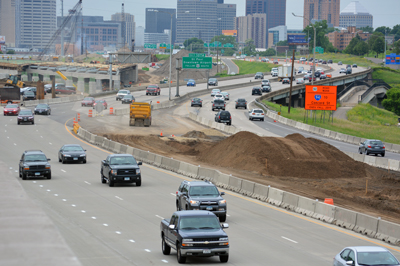
Interstate 35E in St. Paul has two projects taking place, the Cayuga Improvement and the MnPASS projects. Photo by Rich Kemp |
Two major construction projects on Interstate 35E are in full force and have recently reached milestones: the Cayuga Improvement Project in St. Paul and the MnPASS Project in St. Paul, Maplewood and Little Canada.
Cayuga Improvement Project
The Cayuga Improvement Project includes reconstructing I-35E between University and Maryland avenues; replacing the Cayuga Street and Pennsylvania Avenue bridges and the railroad bridges along I-35E; and moving the interchange at Pennsylvania Avenue/Phalen Boulevard to Cayuga Street.
Initial construction on the northbound lanes and east side of the interstate led to the closure of the northbound exit and entrance ramps at Pennsylvania Avenue/Phalen Boulevard and a temporary exit ramp to Cayuga Street. The temporary exit was recently closed and a new Cayuga Street bridge that provides east/west connection between Phalen Boulevard and northbound I-35E access was opened.
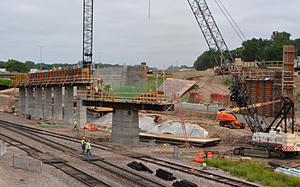
Replacing the Cayuga Street Bridge in St. Paul is part of the Interstate 35E construction project. Photo by Rich Kemp |
Construction continues on the northbound side of the freeway, and includes reconstructing the southbound side of the road. An animation of the project and design is available on MnDOT’s YouTube page.
MnPASS Project/Larpenteur Bridge slide
The MnPASS Project on I-35E between Maryland Avenue in St. Paul and Little Canada Road in Little Canada includes adding a MnPASS Express Lane in both directions, improving the pavement and replacing nine bridges through the corridor. The Arlington Avenue and Wheelock Parkway bridges opened in May. The Larpenteur Avenue Bridge was removed in early June and will reopen in late early July.
The Larpenteur Bridge deck is being built on temporary falsework directly next to the existing bridge. The project team will use an innovative construction technique using hydraulic propulsion to slide the bridge deck onto the new bridge substructure. This technique shortens the overall duration of the bridge construction.
In addition to the bridge replacement work, some long-term traffic shifts and restrictions for I-35E pavement construction work were recently implemented. All traffic was shifted to the southbound side of the freeway, and several ramps within the project area are closed to facilitate northbound I-35E pavement construction. The restrictions are anticipated to remain in place for approximately four months. Similar restrictions will occur in 2015 when crews work on the southbound side of the freeway. An interactive map illustrating the lane restrictions and ramp closures/detours throughout the corridor is available on the project website. |
 |
|

|
 |
TABLE of CONTENTS
 |
Green Line opens between St. Paul, Minneapolis |
|
By Mary McFarland Brooks
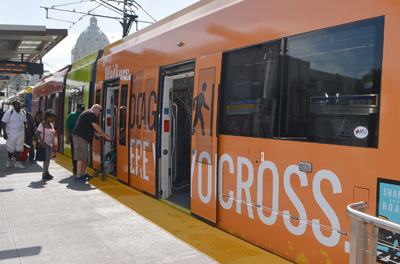
The Green Line light rail train picks up passengers at the Capitol Station in St. Paul. The Green Line starting running between St. Paul and Minneapolis June 14. Photo by Rich Kemp |
For the second time in 60 years, the Twin Cities are again connected by passenger rail along University Avenue, the backbone of the Green Line Light Rail Transit. The wet and windy opening day of the Green Line June 14 did not deter more than 107,000 people from riding the new corridor. Commuters can now access Target Field, the University of Minnesota and Union Depot along the Green Line’s 11 miles of track and 23 stations.
The trains will travel at approximately 35 mph and are projected to provide 13.2 million annual rides by 2030. Traveling the entire corridor, end to end, takes approximately 45 minutes and transports metro and suburban commuters to their jobs, schools, restaurants, sporting events and other destinations adjacent to the corridor.
MnDOT’s Contribution
MnDOT had 17 employees who worked full time on the project and dozens more who worked part time or participated on various committees. MnDOT was responsible for delivering the right of way and provided construction administration, inspections and environmental oversight, worked with utility companies on utility relocations, and headed up the project permit group.
“The Green Line supports MnDOT’s vision of a multimodal transportation system by strengthening the transit mode between St. Paul and Minneapolis,” said Bryan Dodds, Office of Land Management director. “The investment in this new LRT line has created a synergy with the communities along the line, driving a wave of investment and revitalization, increasing economic vitality and creating more vibrant neighborhoods.”
Trains will run 24 hours, with service offered every 10 minutes throughout the day, every 10 to 15 minutes in the evenings, and hourly in the overnight hours.
Transit System
The Green Line will build on the success of the Blue Line, which has served riders between downtown Minneapolis to the Mall of America since 2004. In the first six months of 2013, the Blue Line transported more than four million riders. The system is expected to be connected by the Southwest Line, which will extend 15 miles from Target Field Station in downtown Minneapolis through St. Louis Park, Hopkins and Minnetonka to Eden Prairie. It is scheduled to open in 2018.
Information about Green Line fares is available at: https://store.metrotransit.org/. |
 |
|

|
 |
TABLE of CONTENTS
 |
MnDOT focuses on reducing highway-rail crossing fatalities during Rail Crossing Safety Awareness Month |
By Greg Ruhland, Office of Freight and Commercial Vehicle Operations
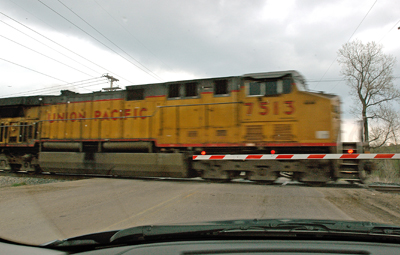
A driver yields the right-of-way to this Union Pacific train at a rural highway-rail crossing. Photo by David Gonzalez |
MnDOT continues its efforts in June to reduce Minnesota train-related crashes and fatalities, as part of Rail Crossing Safety Awareness Month.
“Despite diligent safety, education and technological advances in the rail and transportation industries, drivers and pedestrians need to know that risky behavior around railroad tracks can lead to tragic results,” said Paul DeLaRosa, rail project manager.
MnDOT is upgrading signal equipment and installing crossing gates at 40 locations across the state this year. A total of $7.9 million in federal and state funds will be used to provide these safety improvements, said Bill Gardner, Freight and Commercial Vehicle Operations director.
Warning devices are currently installed at more than 1,500 of Minnesota’s approximately 4,200 public railroad-highway grade crossings.
“MnDOT is committed to making all modes of transportation safe, and that includes drivers and pedestrians crossing railroad tracks,” Gardner said. “We need these rail crossing improvements to save lives.”
Already this year, 25 highway-rail crossing collisions have been recorded across the state. That’s on top of several "near misses" tracked by the railroad industry.
National highway-rail incidents have been on a general decline since the 1970s, but in 2013, there was a 7.7 percent increase over the previous year in the number of pedestrians injured or killed while walking on or near railroad tracks, according to the U.S. Department of Transportation. Similarly, the number of vehicle-related rail crossing incidents in 2013 increased 1.5 percent over 2012.
“Pedestrians should only cross tracks where they are marked with pedestrian crossing markings,” Gardner said. “When the gates are down and crossing signals are flashing, it’s illegal to drive or walk around them.”
Most of the pedestrian incidents happen when people walk around lowered gates and flashing lights, DeLaRosa said.
Safer decisions around tracks can prevent many injuries and deaths each year. For more information, go to MnDOT’s rail safety web page or Minnesota Operation Lifesaver’s website. |
 |
|

|
 |
TABLE of CONTENTS
 |
Joy Penney appointed transportation technology investment manager |
|
By Rich Kemp
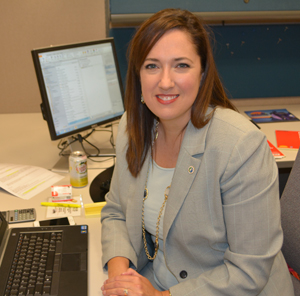
Joy Penny took over the new position of transportation technology investment manager June 16. Photo by Rich Kemp |
Joy Penney is MnDOT’s transportation technology investment manager, effective June 16.
This new position is responsible for providing overall leadership and direction in developing and implementing MnDOT’s information technology investment program to better serve agency customers.
Penney will have agency-wide responsibilities and report to Sue Stein, Corporate Services Division director.
“We’re very excited to have Joy take on this new position,” said Stein. “Her background and experience, including the areas of finance and information technology, will serve us well.”
Penney has 20 years of professional and managerial experience at MnDOT, most recently as the District 4 administrative manager. She has a master’s degree and bachelor’s degree in business administration from Minnesota State University – Moorhead.
Fore more information see http://ihub/itbusiness/. Penny can be reached at joy.penney@state.mn.us or 651-707-7212. |
 |
|

|
 |
TABLE of CONTENTS
 |
Survey results show public values maintenance work, trusts MnDOT |
By Donna Koren, Customer Relations Responding to more than 40 survey questions last fall and winter, 1,100 Minnesotans from across the state provided MnDOT with a wealth of feedback on how the traveling public experiences many aspects of the transportation system.
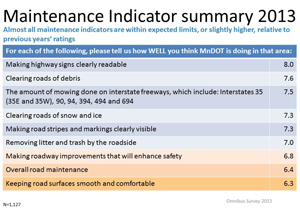
The Omnibus study shows ratings on the majority of the nine maintenance indicators met the department’s goal of seven or higher on a 10-point scale. Graph from the 2013 Omnibus survey |
For more than two decades, MnDOT has relied on the Omnibus tracking survey for valuable, detailed input on the public’s behaviors, experiences and preferences regarding the state’s transportation system. Core questions are tracked and compared year to year, such as the indicators for the maintenance work that the public regularly experiences, and indicators that reflect trust and confidence in the department. The Omnibus also is useful for asking about awareness and responses to outreach programs such as for Zipper Merge and pedestrian safety.
Here are a few highlights from the 2013 survey:
- The public continues to notice and value MnDOT’s core maintenance work, such as clearing roads of snow and ice, ensuring that highway signs are clearly readable and making road stripes and markings noticeably visible. Ratings on the majority of the nine maintenance indicators met the department’s goal of seven or higher on a 10-point scale.
- Overall public trust in MnDOT remains high, with 86 percent agreeing that the department can be relied upon to deliver the transportation system, and 85 percent perceiving that MnDOT prioritizes travelers’ safety. In areas where the public’s confidence is slightly lower, follow-up questions provide details about specific concerns.
- For the first time, in 2013 more than half of Minnesotans statewide - 55 percent - rode a bicycle at least once between April and October, with many more riding at least a few times, and 25 percent riding at least once per week. Results also showed that bicyclists’ perception of riding safety ties to how much they bike. Additional survey questions provided guidance on how MnDOT, local governments and other partners can influence perceptions of bicycling safety.
“The Omnibus survey lets us know whether we’re on track, from the public’s perspective, with how we are planning, funding and supporting transportation throughout Minnesota,” said Mike Barnes, Operations Division director. “The 2013 results show that the districts are doing a good job in meeting the public’s expectations for snow and ice removal and other safety-related services.”
The study is MnDOT’s annual tracking survey that receives responses from 800 Minnesota residents who represent the state's population with an equal portion of residents in metro and Greater Minnesota. When conducting an Omnibus study, surveys are collected until the correct number of respondents that represent the Minnesota population is obtained.
For the first time, the Omnibus study used several methods to survey the public this year. In previous years, MnDOT contacted citizens by landline telephone interviews, the traditional gold standard for survey research. With changing demographics, specifically the rise of the millennial generation, the 18-to 24-year-olds, and changing communication preferences, Customer Relations transitioned the survey to also include cell phone numbers and use the Internet.
Anyone with questions about Omnibus 13 results, or to have the report discussed with individual offices or to get public input on a statewide or local level, contact Donna Koren, Customer Relations Market Research director, at 651-366-4840 or donna.koren@state.mn.us.
|
 |
|

|
 |
TABLE of CONTENTS
 |
Where there’s fire, there’s Ken Graeve |
By Sue Roe
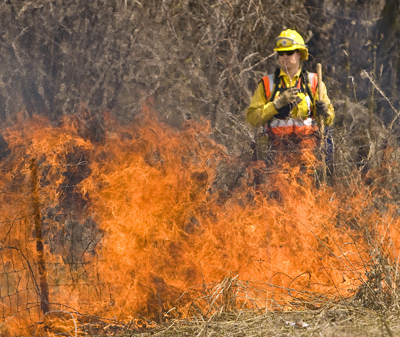
Ken Graeve monitors a fire during a prescribed burn in District 6 recently on I-90 near the Eyota exit. Crews of four or five conduct the burns. Photo courtesy John Olson, Post-Bulletin/Rochester Magazine |
When invasive plant species invade roadside vegetation or native prairie plants need help to grow, Ken Graeve, roadside vegetation manager, and fire crew members suit up. Graeve works with crews in the four districts that have trained crew members to conduct prescribed burns. The crews are trained as basic wildland firefighters and are all experienced in working with roadside prescribed burns.
Graeve has a biology degree from St. John’s University. He worked with a native seed producer in southeastern Minnesota before coming to MnDOT six years ago.
Prescribed burns promote the growth of tall native grasses. Healthy stands of grasses and other plants trap blowing snow and keep it from drifting onto the roadways. Burns also control the growth of weeds, small brush and trees near the roadways.
Currently, about six fires are conducted each year in the four districts. Graeve said MnDOT’s goal is to train more crews so more roadsides can be burned in three-to five-year rotations.
When he’s not working on burns throughout spring and fall, Graeve also supports maintenance for vegetation management and invasive species control. He also reviews projects for vegetation impacts and gives technical support for vegetation establishment during construction, projects with potential impacts to rare plant species and vegetation establishment on wetland mitigation projects.
What are the reasons for doing prescribed burns?
Prescribed fire is used primarily for promoting the growth of native grasses and forbs. Improving the health of desirable vegetation allows it to better provide the services of soil stabilization, storm water management, blowing snow control, and resisting weed infestations. Fire can also be applied to serve more specific objectives, such as weed control, brush control, site preparation for re-seeding, etc.
What are the challenges in doing a prescribed burn?
The most obvious challenge with a prescribed fire is making sure the fire burns intensely enough to accomplish the objectives but not so hot that it can’t be kept within bounds. This requires very specific weather conditions, the right equipment and a well-trained crew. A bigger challenge is smoke management. While the flames will impact a very particular piece of ground, the smoke they produce can affect neighbors and possibly traffic. This requires planning to ensure that the smoke from the fires will not cause problems.
The biggest challenge is coordinating all the pieces that have to come together to pull off a prescribed fire. We have to have the right weather, the right equipment and the right people all at the right time. This requires a lot of support and flexibility from the fire crews and from their supervisors.
What do you enjoy most about your job as roadside vegetation manager?
Working with roadsides at MnDOT is a fun challenge. It is something I can stay motivated about because roadsides are such an important asset. This work takes me out to far-flung places all around the state, and I get to work with a lot of great people. It’s also by no means simple, requiring that we find ways to do high-quality vegetation management at an agency where most of the attention is on the gray infrastructure rather than the green infrastructure. This presents lots of challenges that keep the work interesting.
How do prescribed burns enhance financial effectiveness?
To understand this I need to point out the difference between weed control and vegetation management. A lot of what we do on roadsides is weed control, and roadsides are a bit like people during flu season—if we’re tired and stressed and exposed to a cold virus, we’re likely to get sick. If we’re well-rested and healthy, we can fight off that cold virus. Similarly, a roadside is more likely to “catch” a weed infestation when the vegetation is stressed and thin, leaving more open spaces in which weeds can grow. Spraying those weeds is like taking cold medicine to reduce the symptoms—it makes us feel better for a while, but unless we catch up on sleep and improve our overall health, we’re likely to get sick again. In the same fashion, unless we manage roadsides for healthy, robust vegetation, the weeds will be back, as will other problems, such as erosion, poor storm water management, etc.
So while weed control is a short-term fix that addresses symptoms - weeds, vegetation management is a long-term approach that addresses underlying causes - unhealthy vegetation. Fire is a vegetation management tool, and since we use it as part of the long-term solution to prevent future problems, it can have a lower life-cycle cost than repeatedly treating the symptoms of problems.
Do you or a co-worker have an interesting job to share with readers? Click here to send us your ideas, and we’ll contact you for more information.
Recent employee profiles:
|
 |
|

|
 |
TABLE of CONTENTS
 |
Roberta Dwyer honored by American Association of University Women |
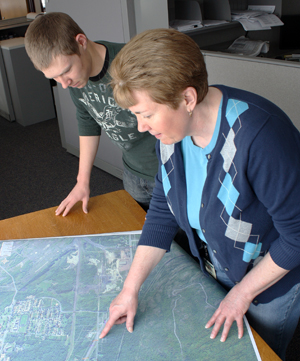
Roberta Dwyer, District 1 Hwy 53 project manager, discusses a map of a Hwy 23 construction project with Daniel Esselstrom, survey crew. Dwyer received an award from the American Association of University Women in June. Photo courtesy of the District 1 |
Roberta Dwyer, District 1 Hwy 53 project manager, received the 2014 Named Honoree award from the American Association of University Women. Each year, the AAUW honors a member who made significant contributions to furthering AAUW’s mission of advancing equality for women and girls through advocacy, education, philanthropy and research.
“Roberta Dwyer has shown a commitment to increasing awareness of opportunities in the engineering field for women in our community,” said Duane Hill, District 1 engineer. “These efforts help MnDOT achieve our goals of creating a diverse workforce. This is well deserved recognition for Roberta’s commitment to community service.”
Dwyer, who is the current president of the Duluth AAUW, led the effort to host the state AAUW conference in Duluth and was instrumental in holding numerous events to acquaint youth with opportunities in the field of engineering and science. |
 |
|
| |
|



